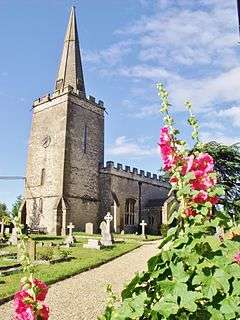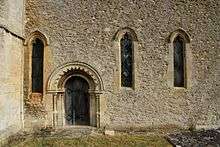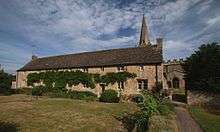Shellingford
| Shellingford | |
 St Faith's parish church |
|
 Shellingford |
|
| Population | 173 (2011 Census) |
|---|---|
| OS grid reference | SU3193 |
| Civil parish | Shellingford |
| District | Vale of White Horse |
| Shire county | Oxfordshire |
| Region | South East |
| Country | England |
| Sovereign state | United Kingdom |
| Postcode district | SN7 |
| Dialling code | 01367 |
| Police | Thames Valley |
| Fire | Oxfordshire |
| Ambulance | South Central |
| EU Parliament | South East England |
| UK Parliament | Wantage |
|
|
Coordinates: 51°38′24″N 1°32′31″W / 51.640°N 1.542°W
Shellingford, historically also spelt Shillingford, is a village and civil parish about 2 1⁄2 miles (4 km) south-east of Faringdon in the Vale of White Horse in Oxfordshire, England. It was part of Berkshire until the 1974 Local Government Act transferred it to Oxfordshire. The 2011 Census recorded the parish's population as 173.[1]
In the 10th century the toponym was spelt Scaringaford and in the 11th century it was Serengeford. 13th century forms of the name included Salingeford, Schalingeford, Shallingford, Sallingford and Schillingford. In the 18th century it was recorded as Shillingworth.[2] The spelling Shillingford has been discontinued to avoid confusion with the village of Shillingford near Wallingford, also in Oxfordshire.
History
Abingdon Abbey held the manor of Shellingford from 931 to 1538. In 1598 the courtier Sir Henry Neville bought the manor. It was later held by the Packer family. In 1738 Sarah Churchill, Duchess of Marlborough bought it as an investment. It was later held by the Goodlake and Ashbrook families.[2]
In the 19th century the Goodlakes built a new house to the north of the village, Kitemore House, to replace the Elizabethan manor house south of the church, which was then demolished.[2]
Between 1931 and 1957 there was an aerodrome, RAF Shellingford, between Shellingford and Stanford in the Vale. A quarry now occupies part of the site.
Parish church
The Church of England parish church of Saint Faith has a late 12th century Norman nave and chancel.[2] The church still has its Norman chancel arch, south door, priest's door and part of the north door.[3] The west tower is an Early English Gothic[3] addition from the early part of the 13th century.[2] In the 14th century[2] the chancel was rebuilt with Decorated Gothic windows[3] and a Decorated wondow was inserted in the south wall of the nave. In about 1400 a chapel was added to the north side of the chancel, but it does not survive.[2] The tower arch was rebuilt in the 15th century.[2] Early in the 16th century[2] two four-light Perpendicular Gothic windows[3] were inserted in the south wall of the nave and another Perpendicular window was inserted in the north wall of the chancel.[3]

The spire and south porch were added in 1625 and three windows in the north wall of the nave were probably added at the same time.[2] The spire was destroyed by lightning in 1848[2] and rebuilt in 1852.[3] The church contains a number of monuments, including one to William, 2nd Viscount Ashbrook (1767–1802) by John Flaxman.[3] St Faith's is a Grade I listed building.[4]
The tower seems to have had a ring of four bells by the early part of the 20th century.[2] The tenor bore the date 1586 but the founder was unidentified. Edward Neale of Burford[5] cast the treble in 1653. Another bell bore no date[2] but may have been cast in about 1599.[6] Henry III Bagley, who had foundries at Chacombe and Witney,[5] cast the final bell of the four in 1738.[2] There is also a Sanctus bell that was cast in 1663. In the 20th century the ring was increased to six, but of the original bells only the Bagley and undated bells survive. Mears & Stainbank of the Whitechapel Bell Foundry cast the current tenor in 1920. In 1998 Whitechapel Bell Foundry cast the present treble and another bell. There is also another bell from the Whitechapel foundry, cast by Thomas II Mears in 1841.[6]
St Faith's is now part of the Benefice of Uffington, Shellingford, Woolstone and Baulking.[7]
References
- ↑ "Area: Shellingford (Parish): Key Figures for 2011 Census: Key Statistics". Neighbourhood Statistics. Office for National Statistics. Retrieved 4 July 2015.
- 1 2 3 4 5 6 7 8 9 10 11 12 13 14 Page & Ditchfield 1924, pp. 475–478
- 1 2 3 4 5 6 7 Pevsner 1966, p. 214.
- ↑ Historic England. "Church of St Faith (Grade I) (1368447)". National Heritage List for England. Retrieved 4 July 2015.
- 1 2 Dovemaster (25 June 2010). "Bell Founders". Dove's Guide for Church Bell Ringers. Central Council of Church Bell Ringers. Retrieved 17 January 2011.
- 1 2 Davies, Peter (24 February 2012). "Shellingford S Faith". Dove's Guide for Church Bell Ringers. Central Council for Church Bell Ringers. Retrieved 1 July 2012.
- ↑ Archbishops' Council. "Benefice of Uffington Shellingford Woolstone and Baulking". A Church Near You. Church of England. Retrieved 4 July 2015.
- ↑ Historic England. "Timber Yard Cottages (Grade II) (1048601)". National Heritage List for England. Retrieved 5 July 2015.
Sources
- Page, W.H.; Ditchfield, P.H., eds. (1924). A History of the County of Berkshire. Victoria County History. 4. assisted by John Hautenville Cope. London: The St Katherine Press. pp. 475–478.
- Pevsner, Nikolaus (1966). Berkshire. The Buildings of England. Harmondsworth: Penguin Books. pp. 214–215.
External links
| Wikimedia Commons has media related to Shellingford. |

